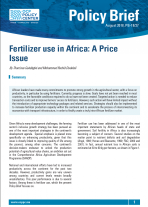Fertilizer Use in Africa: A Price Issue
African leaders have made many commitments to promote strong growth in the agricultural sector, with a focus on productivity, in particular by using fertilizers. Currently, progress is slow. Goals have not yet been reached in most countries, as the favorable conditions required to do so have not been created. Targeted action is needed to reduce transaction costs and to improve farmers’ access to fertilizers. However, such action will have limited impact without the introduction of appropriate technology packages and related services. Strategies should also be implemented to increase fertilizer production capacity within the continent and to accelerate the process of interconnecting its economies with transport infrastructure, in order to finally create a truly intra-African fertilizer market.
Given Africa’s many development challenges, the farming sector’s inclusive growth strategy has been pursued as one of the most important strategies in the continent’s development agenda. Special emphasis is placed more specifically on enhancing productivity, given that this issue is closely linked to improving quality of life among the poorest, among other concerns. The continent’s decision-makers endeavor to unlock the production potential of agricultural value chains, an ambition set out in the Comprehensive Africa Agriculture Development Programme (CAADP).
National and international efforts have led to increased productivity across the continent for the past two decades. However, productivity gains are very uneven among countries and current levels remain broadly unsatisfactory. This poor performance is due to several factors. Among these is fertilizer use, which the present Policy Brief focuses on.
Fertilizer use has been addressed in one of the most important statements by African heads of states and governments. Soil fertility in Africa is also increasingly becoming a subject of concern. In fact, several studies on the matter point to nutrient deficits and soil degradation (Angé, 1993; Henao and Baanante, 1990; FAO, 2000 and 2001). In fact, annual nutrient loss in African soils is estimated at 30 to 60 kg per hectare, as shown in Figure 1.
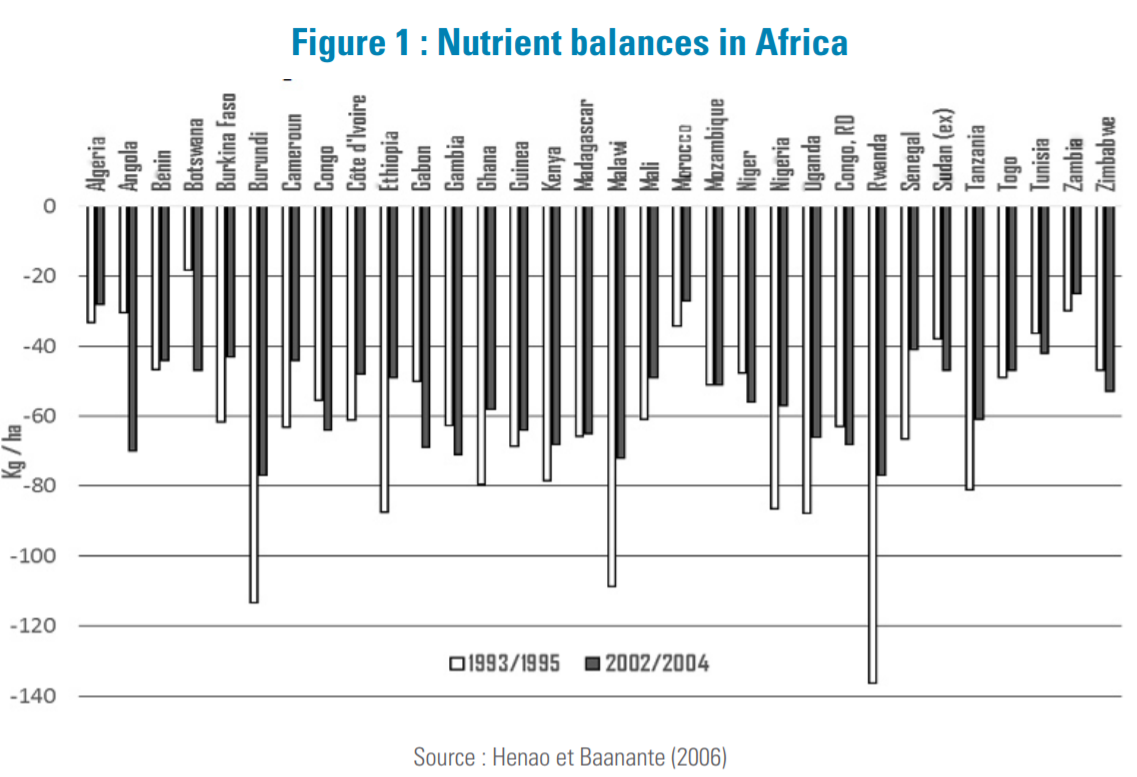
In order to reduce deficits and enhance agricultural productivity, fertilizer input must increase, and fertilizer should be used in a more efficient and effective manner. This would also have environmental benefits. Better and higher use of fertilizer increases yields, and therefore slows deforestation and the conversion of other marginal land into farmland (Bumb, 1995; Wallace and Knausenberger, 1997).
The Abuja Declaration
In its vision, the New Partnership for Africa’s Development (NEPAD), the African Union (AU)’s main technical body, set the goals of enhancing agricultural productivity in Africa and ensuring that the agricultural sector grows by at least 6% annually. Adopted in 2003 by African heads of state and government and an integral part of NEPAD, the CAADP is Africa’s reference framework for sustainable agriculture and food security. In addition to the agricultural growth target, the CAADP also aims for at least 10% of government budget to be allocated to agriculture.
Among the possible means to achieve such goals, the CAADP focuses on fertility and technical progress, which make up two of its four pillars. The first pillar relates to land management and water monitoring systems, implying that strong efforts should be made to improve fertility. The fourth pillar aims to maintain and increase productivity gains by investing in agricultural research, disseminating and adopting technology, as well as implementing institutional and financial reforms to support technical progress.
The rational use of better-suited inputs promotes technological catch-up in developing countries and raises productivity. With this in mind, African ambitions were set out in the Abuja Declaration on Fertilizer for the African Green Revolution (June 2006). With this declaration, AU member states have committed to increasing levels of fertilizer consumption across the continent to 50 kg of nutrients per hectare. Even though the 2015 deadline has already passed, the target has yet to be reached, especially given that almost no country has achieved that goal. A 2011 NEPAD review indicated that little progress had been made and that average levels were well below the minimum target of 50 kg of nutrients per hectare.
Progress Made
Given the available data, before commitments were made in Africa, only in a few countries did fertilizer consumption exceed 50 kg of nutrients per hectare. In the other countries, progress is illustrated in Figure 2, which shows fertilizer consumption in 50 African countries that have not met the Abuja target, over the 2001-2005 and 2010- 2014 periods. In this subset, fertilizer consumption per hectare has only increased by an average of 3 kg between these two periods, from 9 to 12 kg.
In this figure, countries above the dotted diagonal have increased their fertilizer consumption between the two periods. This has been the case for most countries. Quadrants (A, B, C and D) categorize countries according to their performance relative to the average of 50 countries over both periods. Quadrant A shows 11 countries where fertilizer consumption was above average over the 2001- 2005 time period (9 kg/ha) and remained above average (12 kg/ha) in 2010-2014. Quadrant B includes 35 countries where consumption was below average in both periods. In quadrant C, one can see that three countries were above average in the first period but were caught up with or performed more poorly in the second period. Quadrant D indicates that one country was below average in the first period, and subsequently made enough progress to catch up with several countries and exceed the average in the second period.
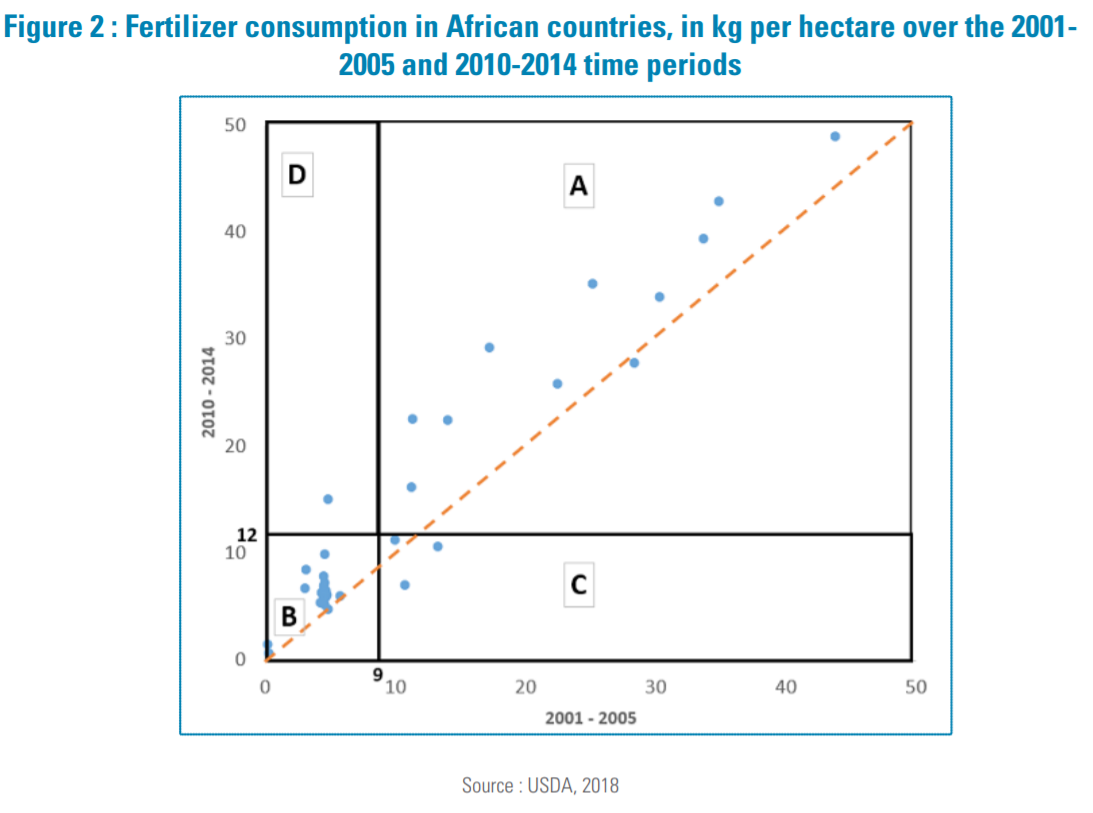
Broadly speaking, progress towards the Abuja target is positive but slow. Understanding the factors that drive such progress is essential to accelerate intensification and productivity gains. Policies to increase fertilizer use should be based on diagnostic studies of the fertilizer sector and on analyses of the reasons behind low levels of fertilizer adoption and/or consumption by farmers.
Drivers of Demand for Fertilizer and Political Implications
To varying degrees, several factors explain low fertilizer use in Africa. These include variables related to cost-effectiveness, but also to access conditions. Once a farmer is convinced of the benefits (or the importance) of using fertilizer, the factor that seems most critical is obviously cost. This determines decisions to adopt and to use fertilizer. At the end of the supply chain, the supply price of fertilizer reflects inefficiencies in the markets along the chain and transport conditions (including quality of transport and storage infrastructure). The supply price also reflects policies to improve access to this input. Product prices are decisive because, when making choices, farmers take into account the relative cost of products in comparison to other inputs and factors of production.
Fertilizer prices in domestic markets vary, depending on prices on the global market, political context, market structure and transaction costs. Some authors also argue that exchange rates have an impact on domestic prices, particularly in a context where most countries import resources (Olusegun, 2012).
Several policies have been implemented to make fertilizer more financially accessible to farmers (in the form of direct subsidies, covering distribution costs, etc.). Analyzing fertilizer market structures and supply chains will help towards adopting targeted policies to address setbacks.
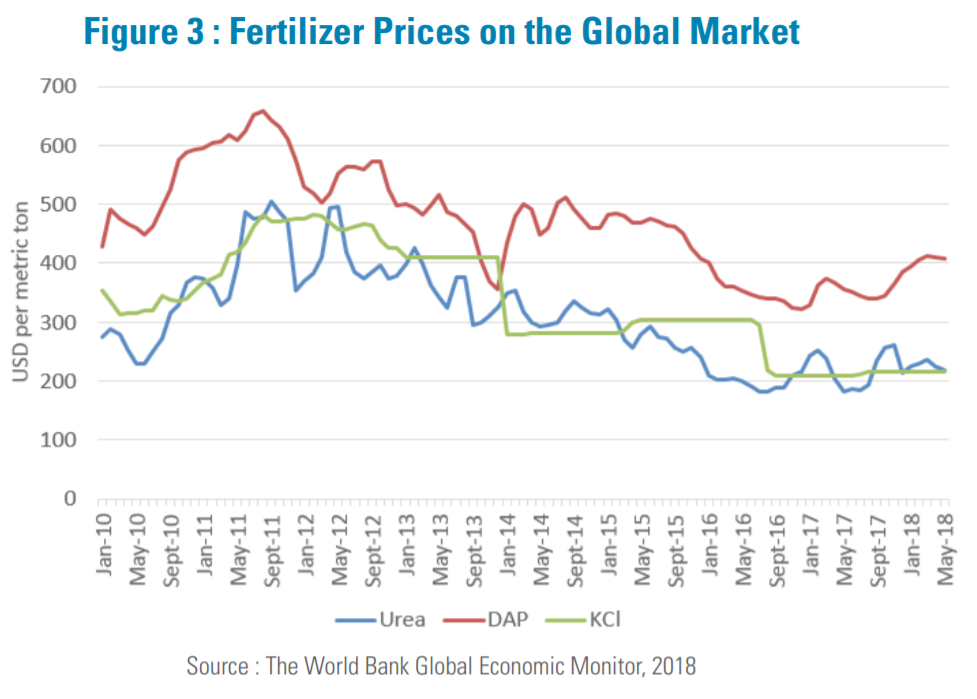
In the current economy, global markets seem more conducive to increasing fertilizer use. As shown in Figure 3, global prices have consistently declined over the past five years. Depending on the policy environment (such as trade or price policies), the various supply chains and transaction costs, this decline was more or less visible in domestic prices. To illustrate this, the case of urea and DAP (diammonium phosphate) is presented here for a few countries in which data are available. Domestic prices of urea and DAP have fallen over the past five years in the countries studied, as shown in Figure 4. The graph also indicates that, in domestic markets, the price of these products may almost double relative to the global market.
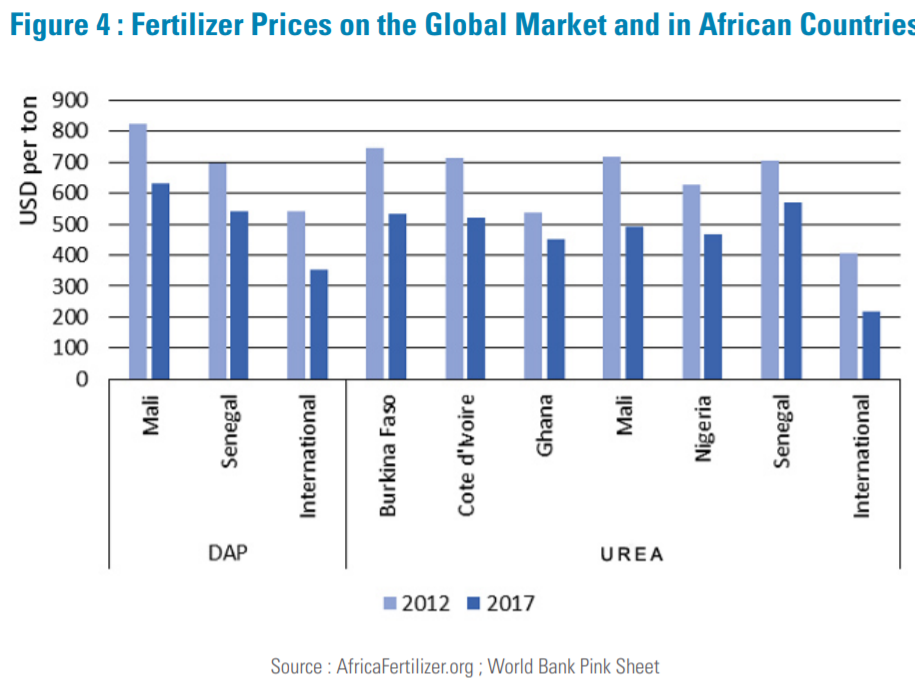
Subsidies in various countries have unevenly reduced fertilizer prices relative to their unsubsidized prices. Figure 5 compares the monthly subsidized and unsubsidized price of fertilizer for some African countries. The level of subsidies can reach up to 80% of the price of urea, as is the case in Zambia, or nearly 40% of the price of DAP, as was observed in Mali. Conversely, the subsidy level may be insignificant in other countries.
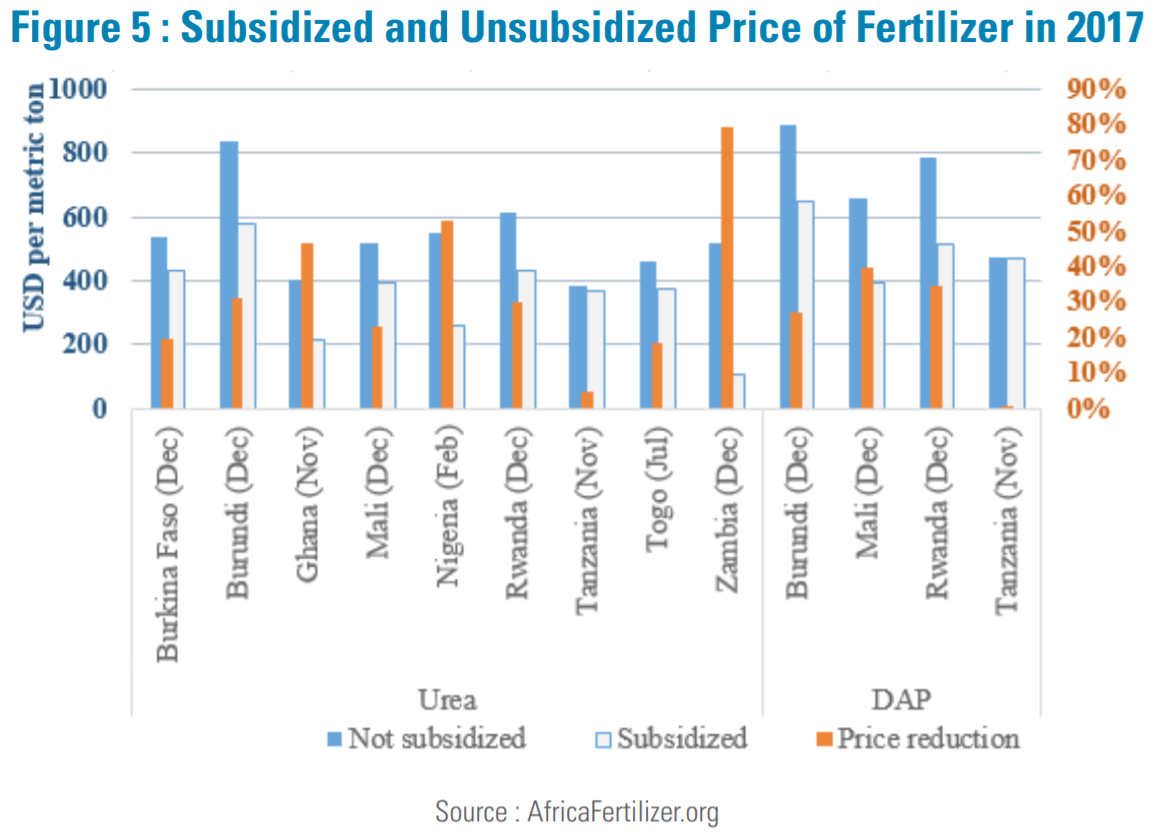
Breaking down the (unsubsidized) cost of fertilizer to farmers gives an idea of why prices reach the levels that they do. In almost all the countries observed, the import price (when fertilizer reaches the border of the importing country) of urea and DAP accounts for the bulk of the final price (see figures 6, 7, 8 and 9). However, transaction costs within the country are quite high. Lowering these would significantly reduce prices to farmers, excluding subsidies, and would probably reduce subsidy expenses to boot. In countries such as Ghana, Mali and Senegal, minimizing domestic transaction costs is likely to reduce the price of urea to 300 dollars a ton or less, i.e. half the current price level. For DAP, prices could be brought down to 500 dollars a ton or less by reducing domestic transaction costs in Kenya and Tanzania, where prices could fall by 43% and 40% respectively.
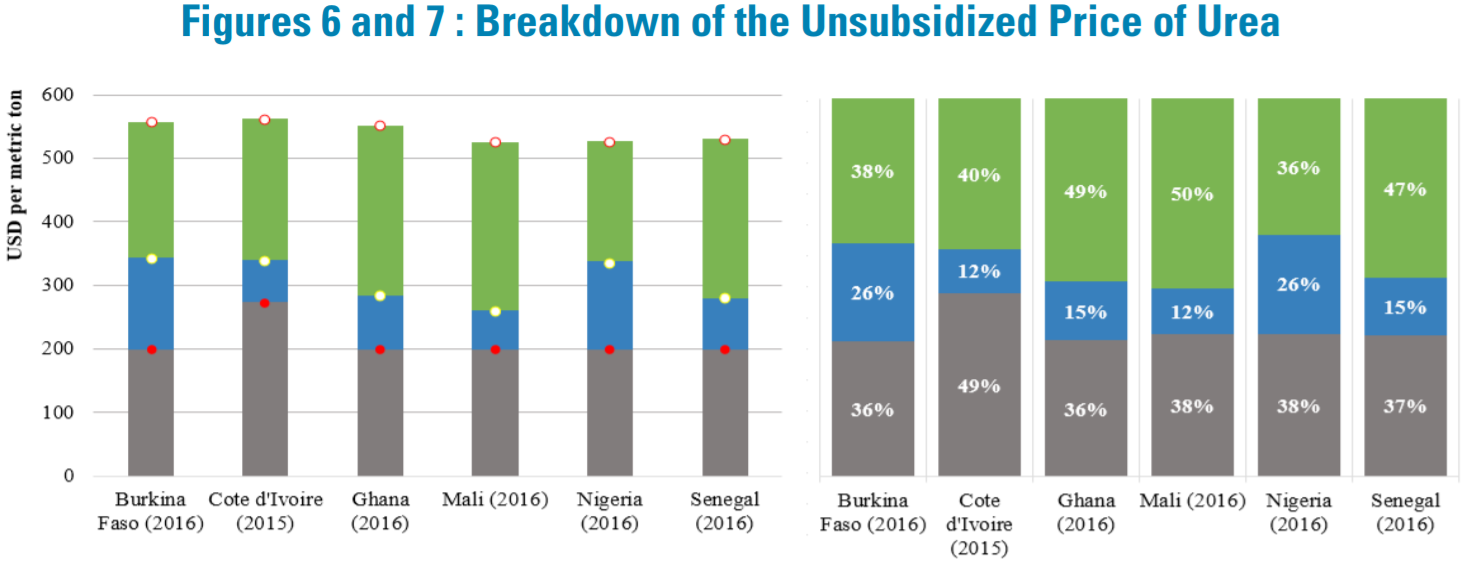
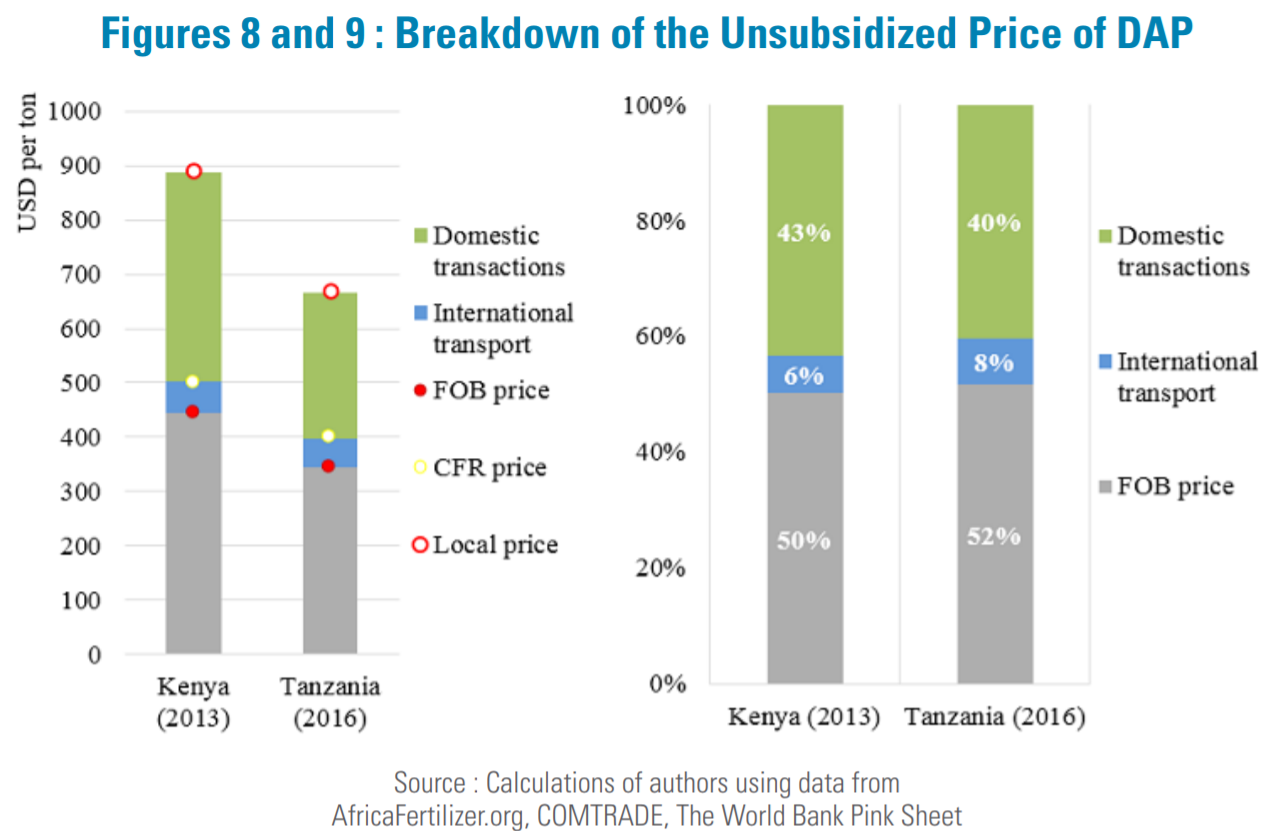
Strategies to reduce import prices should also be considered. Measures that will significantly reduce the price of fertilizer include building regional capacity to produce fertilizer at a cheaper cost, optimized use of existing capacity, and creating favorable conditions for competition in the fertilizer sector (Hernandez and Torero, 2018). The share of international transport costs should be reduced by investing in road and railroad infrastructure, creating maritime transport routes and promoting the development of a competitive market. Thus, it seems necessary to facilitate exchanges between African countries, and to create a business climate conducive to investments in local fertilizer production capacity and transport services.
Similarly, within countries, efforts should be continued to improve the quality of transport and storage infrastructure. Differences in fertilizer prices between cities within a country attest to the variable quality of infrastructure, leading to additional costs. Figures 10 and 11 show price differences between cities, in relation to a reference city within the same country. For instance, the price of urea in Ziguinchor (Senegal) is nearly 190% of its price in Dakar. In other countries, price differences are relatively smaller. Similarly, in Ibanda (Uganda), DAP is about 50% more expensive than in Kampala; smaller differences were observed in other cities and countries.
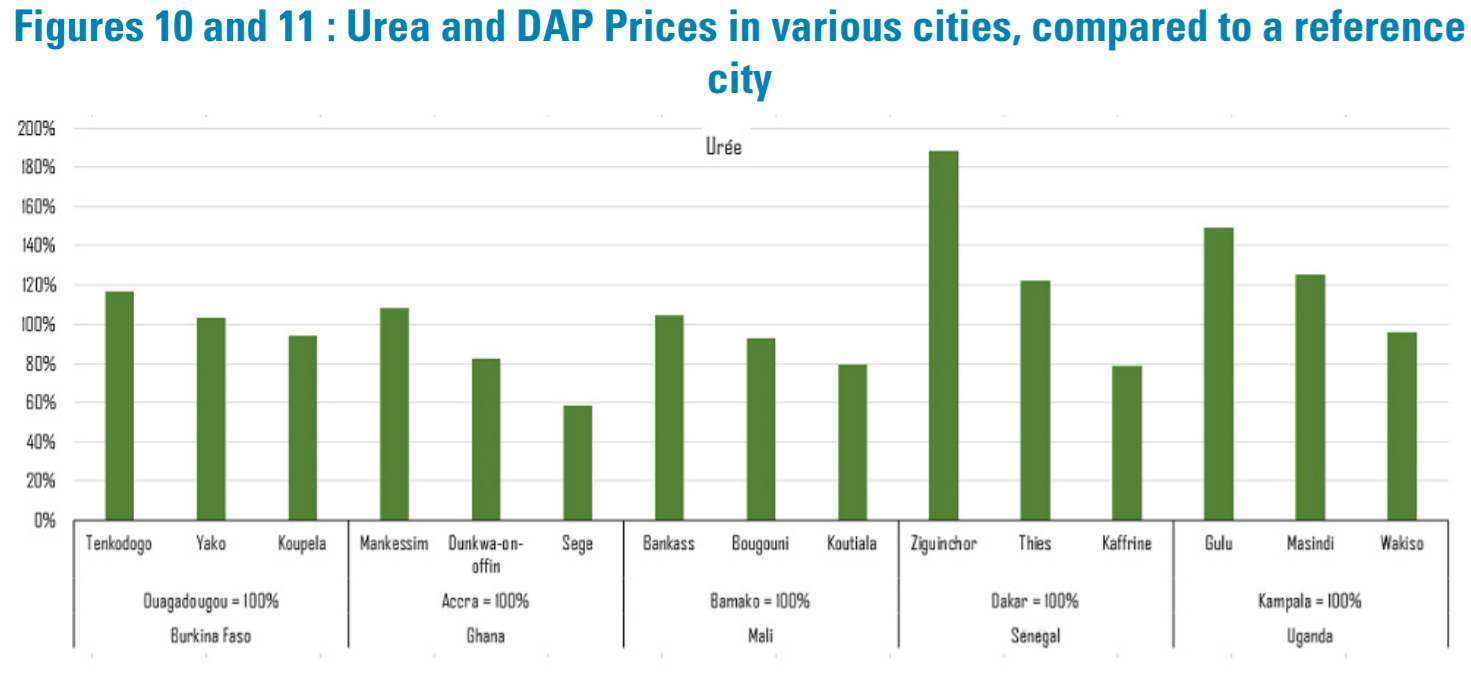
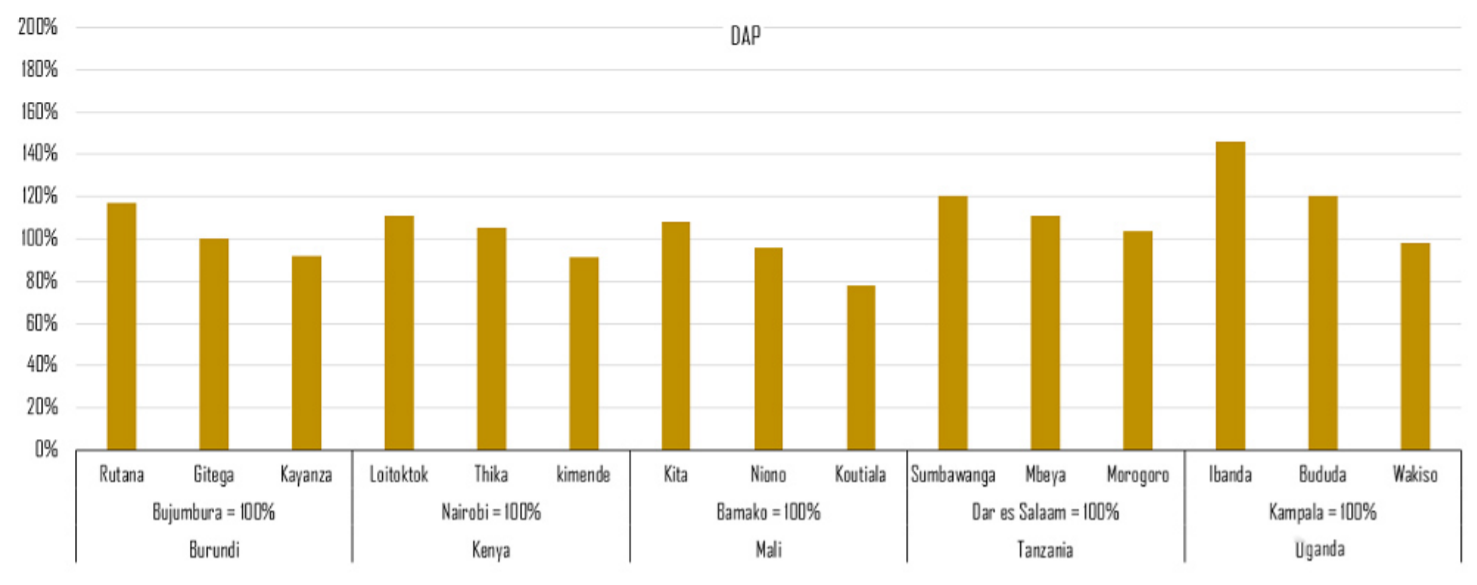
Source: Calculations by authors using data from AfricaFertilizer.org
Managing Drivers beyond Price
However, affordability is not a sufficient condition for farmers to use fertilizer. The environment also plays a decisive role. In rain-fed agriculture, fluctuations in rainfall can considerably influence fertilizer use (Naseen and Kelly, 1999), given that water input has a crucial impact on how plants react to fertilizers. Irrigation helps to lessen the dependence on climate by regularly supplying water. More advanced techniques also make it possible to combine fertilization and irrigation (fertigation).
Moreover, technological progress in the production system influences whether a farmer decides to adopt and use fertilizer. Mechanization, irrigation, or the use of plant protection products are all normally associated with more rational fertilizer use. Policies can only succeed if they specifically target fertilizers as part of a range of actions aimed at adopting suitable technology and adequate related services.
Because human capital is also essential to facilitate fertilizer adoption and improve its use, it is necessary to strengthen agricultural advisory services. Today, ICTs offer great opportunities to develop cheap and effective agricultural advisory services. Beyond extension services regarding farming techniques and research results, competitive markets for credit, insurance, product and input information, and other related services should rapidly emerge. Agricultural policies would be more effective if they were to target these sub-sectors and help the private sector create this ecosystem.
To conclude, fertilizer consumption in Africa remains low - too low to reach desired productivity levels. This is attributable to often-excessive trading margins due to significant market distortions, inadequate infrastructure and under-used potential to produce and trade fertilizer within the continent. Any policy aimed at enhancing agricultural productivity or food security should be part of a consistent set of macro-economic, monetary and trade policies and investment in national and transnational public infrastructure and services.










